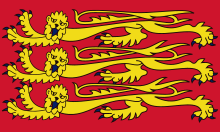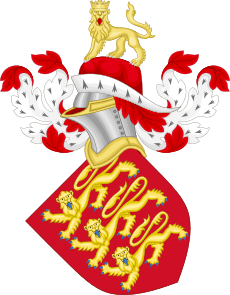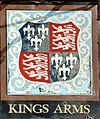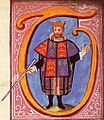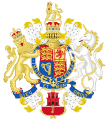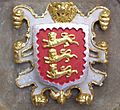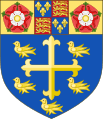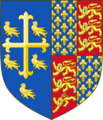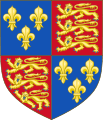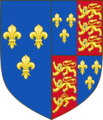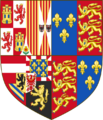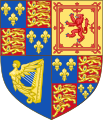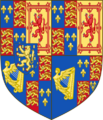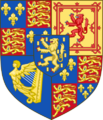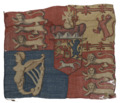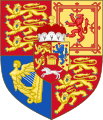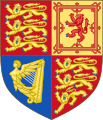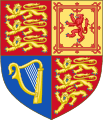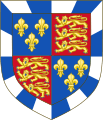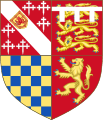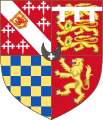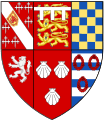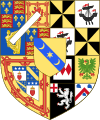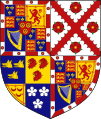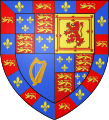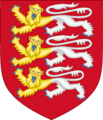Royal arms of England facts for kids
Quick facts for kids Royal arms of England(Arms of Plantagenet) |
|
|---|---|
 |
|
| Armiger | Monarchs of England |
| Adopted | Late 12th century |
| Blazon | Gules, three lions passant guardant in pale or armed and langued azure |
| Supporters | Various |
| Motto | Dieu et mon droit |
| Order(s) | Order of the Garter |
| Use |
|
The royal arms of England are special symbols that have been used by England's rulers for a very long time. They first appeared in a clear design around the year 1200. These arms were personal symbols for the Plantagenet kings who ruled England starting in 1154.
Today, these arms are often seen as a symbol for the nation of England. However, in the world of heraldry (the study of coats of arms), only people or groups can have arms, not entire countries. The design of the Plantagenet arms is described as: Gules, three lions passant guardant in pale or armed and langued azure. This means there are three gold lions with blue tongues and claws. They are shown walking but looking at you, stacked one above the other, on a red background.
This design has stayed the same since Richard I of England (who ruled from 1189 to 1199) made it official. Over time, it has been combined with the arms of other kingdoms, like France, Scotland, and Ireland. This happened as England's rulers formed new alliances or claimed new lands.
Contents
What do the Royal Arms look like?
The main part of the royal arms is a shield. On this shield, you see three golden lions. They are shown walking, but their heads are turned to face you. These lions have blue tongues and claws. They are placed one above the other on a bright red background.
Even though they are called "lions," some experts in heraldry from France used to call them "leopards." This was because of the way they were shown walking and looking at you. But it's the same animal, just with different names depending on its pose.
How did the Royal Arms begin?
Lions were used as symbols by earlier rulers in England, like the Vikings and Normans. But a clear system for English coats of arms started in the late 1100s.
The first time we see a shield with three lions is on the Great Seal of Richard I of England, also known as Richard the Lionheart. His first seal showed one or two lions. But in 1198, he changed it to three lions walking and looking forward. This might have shown his three main roles: King of England, Duke of Normandy, and Duke of Aquitaine.
Richard's brother, John of England, continued to use the three-lion design when he became king. This made it the official and lasting design for the royal arms of England.
How did the Royal Arms change over time?
Claiming the French Throne
In 1340, Edward III of England claimed he should be the King of France. To show this claim, he added the French royal arms to his own. He put the French symbols (golden lilies on a blue background) in the most important parts of his shield. This started the Hundred Years' War between England and France.
The way the French arms were shown on the English shield changed a few times. When the French king changed his arms to show only three lilies, the English arms followed suit.
Joining with Scotland and Ireland

In 1603, Elizabeth I died without children. The throne of England went to James VI of Scotland, who became James I of England. This event was called the Union of the Crowns. It meant England and Scotland now shared the same king.
Because of this, the royal arms of England and Scotland were combined. The arms of Ireland were also added. This new combined coat of arms became the royal coat of arms of the United Kingdom in 1707, when England and Scotland officially joined to form Great Britain.
The three lions of England are still a very important part of the United Kingdom's royal arms today. They appear in the first and fourth sections of the shield.
What is the Royal Banner of England?
The Royal Banner of England is a flag that shows the royal arms of England. It's also called the Banner of the Royal Arms. When this flag was flown in battles long ago, it meant the king or queen was present.
It's important to know that this banner is different from England's national flag, the St George's Cross. The St George's Cross represents the land of England. But the royal banner represents the power and authority of the ruler.
What other parts make up the Royal Arms?
Besides the shield, other symbols were added to the royal arms over time. These include a crest, supporters, a motto, and symbols from an order of knighthood. Together, all these parts make up the full "achievement" of arms.
The Royal Crest
The first extra part added to the shield was the crest. This is a symbol placed above the shield. Edward III of England was the first to use a royal crest widely. His crest showed a golden lion, wearing a crown, standing on a special hat called a chapeau.
The design of the crest changed a little over the years. But since the time of Henry VIII, it has been a golden lion standing and looking forward, wearing a royal crown, placed on top of a royal crown.
The helmet under the crest also changed. Originally, it was a simple steel helmet. Later, a special gold helmet with bars was used only for the royal arms. A decorative cloth, called mantling, hangs from the helmet. It was first red and white, but Elizabeth I changed it to gold and white.
Animal Supporters
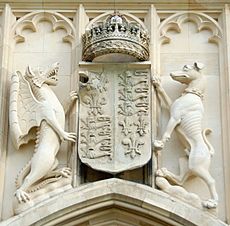
Animal supporters are figures that stand on either side of the shield, holding and protecting it. They first appeared in English heraldry in the 1400s. At first, they changed often. But Edward IV of England made their use more regular.
Different animals were used as supporters. For example, Richard III of England used a wild boar. Henry VII of England added a red dragon, which was a symbol of his family, the Tudor dynasty. This dragon was also used by Henry VIII and Elizabeth I.
After England and Scotland united, the supporters for the British monarch became a lion (for England) and a unicorn (for Scotland). These are still used today.
The Garter and Motto
Edward III of England started the Order of the Garter around 1348. Since then, the royal arms have included a blue band or circlet around the shield. This band has the order's motto written on it in gold letters: Honi soit qui mal y pense. This old French phrase means "Shame be to him who thinks evil of it."
A motto, which is a short phrase, was first used by Henry IV of England in the early 1400s. His motto was Souverayne (meaning "sovereign"). His son, Henry V of England, used the motto Dieu et mon droit, which means "God and my right." This motto has been used by British monarchs since 1714 and is still part of the Royal coat of arms of the United Kingdom.
Other monarchs used different mottoes. For example, Elizabeth I used Semper Eadem, meaning "always the same."
Where can you see the Royal Arms today?

Even though England is now part of the United Kingdom, the royal arms of England are still used. They are one of the most important national symbols of England.
You can see the three lions on the badges of many English national sports teams, like the Football Association (soccer) and the England cricket team. The Royal Mint has even put the three lions on British one-pound coins.
The royal arms also appear on the special uniforms, called tabards, worn by English officers of arms. These officials perform important ceremonial duties, like at the coronation of the British monarch or the State Opening of Parliament.
Many old English towns and councils use the three lions in their own coats of arms, often with small changes to make them unique. For example, the town of Faversham uses three lions, but their hindquarters are silver.
-
The arms worn by the England cricket team.
-
Thomas Hawley, an English officer of arms, wearing a tabard with the royal arms of England.
-
Edward, the Black Prince, wearing a surcoat with the royal arms of England.
-
The arms of Oriel College, Oxford using the royal arms of England with a silver border.
-
The Flag of Detroit uses a stylized version of the royal arms to symbolize former British control.
Images for kids
-
The three lions attributed to early English kings by Matthew Paris in the 1250s.
-
The royal standard of the United Kingdom used in Scotland.
-
The arms of Faversham Town Council.
See also
 In Spanish: Escudo de Inglaterra para niños
In Spanish: Escudo de Inglaterra para niños



